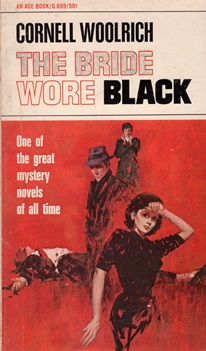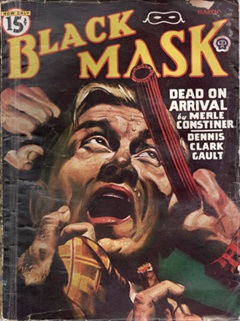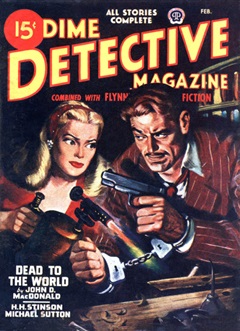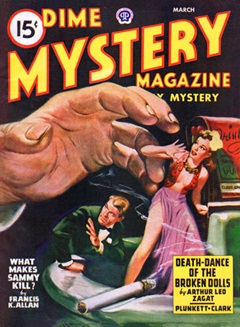
 Mollé Mystery Theatre (1943-51) aired “The Bride Wore Black” on February 7, 1947 as the 159th of its estimated 237 episodes from its 1943-48 original run before it switched to CBS for its final 3 years, of which only 73 of the 237 are known to still remain in circulation. It would exist under several name changes for another six years or so, and as noted would switch from its original network, NBC, to CBS (1948-51), and then ABC. Its glory years as a first class mystery show are acknowledged as those comprising its original incarnation at NBC (i.e. 1943-48). This episode is the 8th we have run since the first in 2018, and also our first in almost a year with the previous episode appearing in May of 2023.
Mollé Mystery Theatre (1943-51) aired “The Bride Wore Black” on February 7, 1947 as the 159th of its estimated 237 episodes from its 1943-48 original run before it switched to CBS for its final 3 years, of which only 73 of the 237 are known to still remain in circulation. It would exist under several name changes for another six years or so, and as noted would switch from its original network, NBC, to CBS (1948-51), and then ABC. Its glory years as a first class mystery show are acknowledged as those comprising its original incarnation at NBC (i.e. 1943-48). This episode is the 8th we have run since the first in 2018, and also our first in almost a year with the previous episode appearing in May of 2023.
Cornell Woolrich (1903-1968, photo top right), under the pen name William Irish, saw his novel The Bride Wore Black published in 1940. While it was his 7th novel it was his first in the noir/pulp form, the style he was to be best known for in years to come. Iconic French film director François Truffaut (1932-1984) would direct the novel’s 1968 film adaptation. It is no secret that Truffaut was well known to science fiction fans for also directing the film of Ray Bradbury’s novel Fahrenheit 451 in 1966 (his first non-French film), which I think it fair to say is a minor classic.
As to the novel, Woolrich opens the book with a line from Guy de Maupassant’s short story “Le Horla”: “For to kill is the great law set by nature in the heart of existence! There is nothing more beautiful and honorable than killing!” And to prove the observation, along with convolutions and twists, Cornell fills his novel with murder after murder after murder, enough to fill an undertaker’s dance card. But it is the who and why that tell this tale, adapted for a 30-minute radio play as admirably as could be expected while still retaining enough of the flavor of the much longer and more intricate and emotionally nuanced novel. Later in his career, following a string of successful novels and short stories, Woolrich’s biographer would write that “Woolrich [was] the fourth best crime writer of his day, behind Dashiell Hammett, Erle Stanley Gardner and Raymond Chandler.” If you find yourself in one of those moods where murder, mayhem, and revenge can only be locked back in the cellar where they belong unless faced head on and stared down, then put your feet up, relax, and find out why “The Bride Wore Black.”
Play Time: 29:25
{“The Bride Wore Black” aired at 9 PM on a Friday evening in early February of 1947. The next morning found the neighborhood gang at the nearby corner newsstand for more tales of evil deeds and murder most foul. Black Mask (1920-51) was the undisputed king of the detective pulps, having published many a future classic, including the serialization of Dashiell Hammett’s The Maltese Falcon beginning in its September 1929 issue. It was a bi-monthly in 1947. Dime Detective (1931-53) was one of its publisher’s most popular magazines, a testament to its longevity. A slight bit of irony can be seen on the cover of the issue below. While the title proclaims the magazine costs but a “dime,” the price adjacent to that part of the title logo clearly shouts 15 cents. The price went from 10 to 15 cents with the September 1944 issue but the title remained the same. Dime Detective was a monthly in 1947. Dime Mystery (1932-50), companion magazine from the same publisher as Dime Detective, while not quite as long-lived as its fellow pulp, nevertheless enjoyed an enthusiastic readership. Begun as a mainstream pulp, it soon graduated to a magazine featuring strange tales of weird menace that insured its success and set it apart from others in the mystery field. Dime Detective went from a dime to 15 cents in September of 1944 and Dime Mystery followed suit in December of 1944. It too retained its original title following the price hike. Though a bi-monthly, it managed to squeeze in two extra issues at the end of the year for a total of 8 in 1947.}
[Left: Black Mask, 3/47 – Center: Dime Detective, 2/47 – Right: Dime Mystery, 3/47]



To view the entire list of weekly Old Time Radio episodes at Tangent Online, click here.